Category — Rare Manuscripts
“A Tale of Two Manuscripts Reunited” – 14th Century Medieval Love Poem
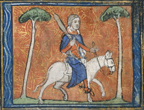 Two 14th Century love poems have been reunited at the University of Chicago. From their press release:
Two 14th Century love poems have been reunited at the University of Chicago. From their press release:
The University of Chicago Library acquired a 14th-century manuscript of “Le Roman de la Rose,” or “The Romance of the Rose” – which scholars have referred to as the most popular medieval love poem – reuniting it after a 100-year separation with a manuscript with which it was previously bound.
In 1907, the manuscript of “Le Roman de la Rose” was separated from that of “Le Jeu des Echecs Moralise,” or “The Moralized Game of Chess,” which the University of Chicago Library acquired in 1931.
Both manuscripts will be on display in the Library’s Special Collections Research Center at 1100 E. 57th St., beginning Feb. 14 as part of the exhibition: “Romance and Chess: A Tale of Two Manuscripts Reunited.” Opening remarks will be made at 12:30 p.m. at the Valentine’s Day opening by Alice Schreyer, Director of the Special Collections Research Center; Daisy Delogu, Assistant Professor of Romance Languages and Literature; and Aden Kumler, Assistant Professor of Medieval Art and Architecture at the University of Chicago. The event is free and open to the public. The exhibit will run through March 14.
“Bringing the two parts of this book back together will enable discoveries that would not be possible if they remained apart,” Schreyer said.
Added Delogu, “This ‘Le Roman de la Rose’ manuscript has extraordinary potential to enrich research and teaching opportunities here at Chicago, and will be of interest to scholars of manuscript culture and literary studies worldwide. ‘Le Roman de la Rose’ is arguably the single-most influential vernacular text of the late French Middle Ages.”
These beautiful manuscripts are currently on display at the University of Chicago. You can learn more about the history of these 14th century poems at the University of Chicago Library web site.
March 4, 2008 Comments Off on “A Tale of Two Manuscripts Reunited” – 14th Century Medieval Love Poem
The Devil’s Bible or Codex Gigas Goes on Display September 20th
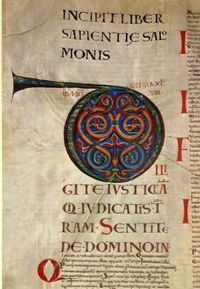 The Devil’s Bible or Codex Gigas is the biggest medieval book in the world. It has a fascinating history and legend. It will be on public display for the first time in many years at the National Library of Sweden on September 20th. From The Prague Post:
The Devil’s Bible or Codex Gigas is the biggest medieval book in the world. It has a fascinating history and legend. It will be on public display for the first time in many years at the National Library of Sweden on September 20th. From The Prague Post:
…legend holds that a monk was sentenced to be buried alive for a breach in Benedictine conduct. In order to forgo his punishment, he agreed to make the most magnificent book the world had ever seen in honor of his brotherhood. The catch was that he was given just one night to complete this Herculean task.
Around midnight, the monk realized he would not be able to finish by daylight, so he invoked the devil to help him, selling his soul in the process. As a tribute to his helper, the monk included a quirky image of the devil within the manuscript, thus giving the book its nickname.
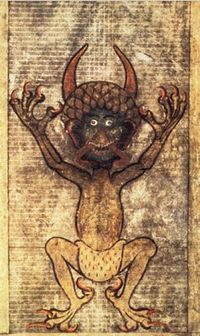 This medieval illuminated manuscript is extremely important. It’s size alone makes it unique. From The Prague Post:
This medieval illuminated manuscript is extremely important. It’s size alone makes it unique. From The Prague Post:
Made of the skins of about 160 animals — some say donkeys, others say calves — the manuscript measures a king-size 90 x 50 x 22 centimeters (roughly 36 x 20 x 9 inches) and weighs 75 kilos (165 pounds), requiring two people to lift it.
 It was first mentioned towards the end of the 13th century and probably dates from the early years of that century. Analysis of the writing style have led to the hypothesis that the book is the work of an individual scribe.
However, what is most important about this phenomenal work is the content. From The Prague Post:
The leather parchment pages contain both the Old and New Testaments of the Bible in pre-Vulgate Latin and much more: a Penitential (a priest’s manual of sins and suitable penance); Isidore of Seville’s Etymologiae, a 20-volume encyclopedia from the seventh century; Josephus’ Antiquities of the Jews; a necrology of the Podlažice monastery as well as a list of all the living monks in Podlažice; and numerous texts of mystical incantations for everything from curing illnesses to catching thieves.
Individuals swayed by mystical thinking believe the incantations in the manuscript have real power and, when the Devil’s Bible was displayed many years ago at the National Museum of Sweden, it was attacked. Thus, considerable security and secrecy surround the current display. For more information on this beautifully illuminated manuscript, visit the National Library of Sweden website.
[tags]codex gigas, devil’s bible, national library of sweden, illuminated manscript, medieval manuscript, medieval scribe[/tags]
September 13, 2007 Comments Off on The Devil’s Bible or Codex Gigas Goes on Display September 20th
Medieval Treasures from the Cleveland Museum of Art Travel to the Ghetty
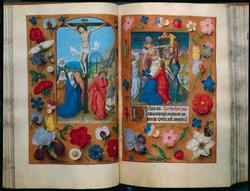 The Cleveland Museum of Art is the holder of many rare and beautiful medieval treasures including the Hours of Queen Isabella the Catholic, Queen of Spain, shown on the left. If you are in southern California this fall, you will be able to view part of this collection at the J. Paul Ghetty Museum. From the Ghetty press release:
The Cleveland Museum of Art is the holder of many rare and beautiful medieval treasures including the Hours of Queen Isabella the Catholic, Queen of Spain, shown on the left. If you are in southern California this fall, you will be able to view part of this collection at the J. Paul Ghetty Museum. From the Ghetty press release:
The Cleveland Museum of Art houses one of the finest and most comprehensive collections of Early Christian, Byzantine and European Medieval art in the world. This remarkable collection was largely acquired over a period of 90 years and formed by two of America’s most distinguished medievalists, the museum’s second director, William Milliken, and the collection’s former curator, William Wixom. The Cleveland Museum of Art’s $258 million renovation and expansion project created the opportunity for the first traveling exhibition to showcase more than 120 masterpieces in a variety of media from its medieval collection. Some of these objects will travel for the first time since they were acquired by the Cleveland Museum of Art.
“This exhibition offers a unique opportunity to bring some of the world’s finest medieval treasures to Los Angeles,†says Michael Brand, director, the J. Paul Getty Museum. â€It will present highlights from the Cleveland Museum of Art’s collection chronologically according to their place of origin, allowing visitors to appreciate the aesthetics of a particular time and place, as well as understand the general artistic progression during this significant period in European art.â€
[tags]cleveland museum of art, j. paul ghetty museum of art, medieval manuscript, medieval art[/tags]
August 22, 2007 Comments Off on Medieval Treasures from the Cleveland Museum of Art Travel to the Ghetty
The Book of Kells in the News
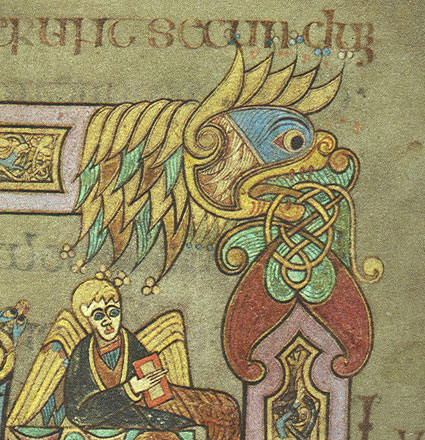
There may be no more famous example of an illuminated manscript than the Book of Kells. While it is well known as one of the most beautiful surviving illuminated manscripts, surprisingly, very little is actually known about the manuscript and its origins. Finally, modern science will be used to learn more about this treasure. From the Dublin Journal as reported in the New York Times:
Experts at Trinity College in Dublin, where the Book of Kells has resided for the past 346 years, are allowing a two-year laser analysis of the treasure, which is one of Ireland’s great tourist draws.
The 21st-century laser technology being used, Raman spectroscopy, encourages hopes among those with a romantic view for an ecclesiastical intrigue like “The Da Vinci Code†or “The Name of the Rose.â€
But the precise subjects are more mundane. The laser will study the chemicals and composition of the book, its pigments, inks and pages of fine vellum. Experts estimate that 185 calves would have been needed to create the vellum on which the art and scriptures were reproduced.
This news happens to coincide with the opening of The Medieval Scriptorium’s on-line gallery of images from the Book of Kells. I have to admit that the gallery is not complete. I haven’t had time to finish all of the captions for the images but I decided to introduce it in this post in light of the recent story referenced above.
[tags]Book of Kells, illuminated manuscript, celtic, calligraphy[/tags]
May 29, 2007 1 Comment
The Bedford and Sobieski Books of Hours Now on Display at the British Library
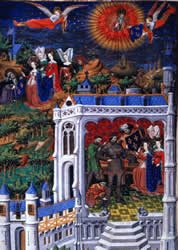 The Bedford Book of Hours is going to be on display at the British Library next week. This is one of the most magnificent illuminated manuscripts in the world. It dates from the early 15th century and every single page in the over 500 hundred page book of hours is illustrated. The illustrations and illuminations are vivid and lush. On display with the Bedford Hours is the Sobieski Hours. It is also from the early 15 century. Both illuminated masterpieces are credited to an artist known as the “Bedford Master.” From the 24 hour museum:
The Bedford Book of Hours is going to be on display at the British Library next week. This is one of the most magnificent illuminated manuscripts in the world. It dates from the early 15th century and every single page in the over 500 hundred page book of hours is illustrated. The illustrations and illuminations are vivid and lush. On display with the Bedford Hours is the Sobieski Hours. It is also from the early 15 century. Both illuminated masterpieces are credited to an artist known as the “Bedford Master.” From the 24 hour museum:
The British Library is displaying two masterpieces of medieval art together for the first time in an exhibition celebrating the 15th century artist, the ‘Bedford Master’, and the collections of the manuscript owners.
Running until July 2 2007, The Bedford Hours: Owners and Illuminators, brings the Bedford Hours and the Sobieski Hours together, both lavishly illustrated medieval manuscripts by the Bedford Master (so called in honour of his noble patron the Duke of Bedford).
The 24 hour museum continues:
The identity of the Bedford Master remains uncertain, despite his having been among the leading and most prolific painters of his day. Some scholars tentatively identify him as the Alsatian artist Haincelin of Hagenau, recorded in Paris as a court painter to the Dauphin Louis de Guyenne.
This may very well be a once in a lifetime opportunity to see the very best examples of Gothic Parisian illumination. These books are the pinnacle of Gothic calligraphic art.
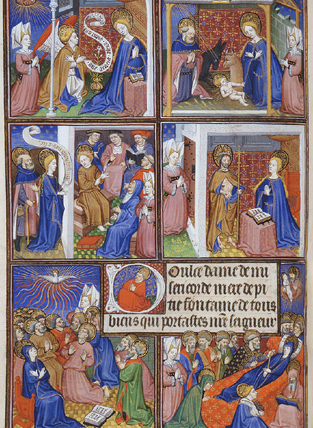
[tags]illuminated manuscripts, book of hours, bedford hours, sobieski hours, gothic alphabet, gothic calligraphy, british library[/tags]
April 16, 2007 Comments Off on The Bedford and Sobieski Books of Hours Now on Display at the British Library

